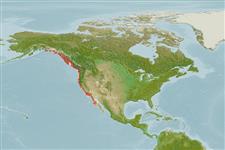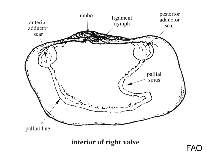Panopea generosa (Gould, 1850)
Pacific geoduck| Native range | All suitable habitat | Point map | Year 2050 |

|
| This map was computer-generated and has not yet been reviewed. |
| Panopea generosa AquaMaps Data sources: GBIF OBIS |
تصوير گوگل | No image available for this species;
drawing shows typical species in Hiatellidae.
رده بندی / Names اسامي عام | مترادف | CoL | ITIS | WoRMS
Bivalvia | Adapedonta | Hiatellidae
Environment: milieu / climate zone / تغييرات عمق / distribution range بوم شناسي
; تغييرات عمق 0 - 110 m (مرجع 865). Temperate; 61°N - 26°N, 146°W - 112°W (مرجع 104413)
Distribution كشورها | مناطق سازمان خوار و بار جهاني (FAO) | Ecosystems | ظهور | معرفي
Eastern Pacific: From Alaska to Baja California. Subtropical to temperate.
Length at first maturity / Size / Weight / سن
بلوغ: Lm ? range ? - ? cm Max length : 17.5 cm SHL جنس نر / بدون خواص جنسي; (مرجع 865); بيشينه سن گزارش شده: 100 سال ها (مرجع 8702)
Life cycle and mating behavior بلوغ | تولید مثل | تخم ریزی | Eggs | Fecundity | Larvae
مآخذ اصلی
مراجع | هماهنگ كننده | همكاران
Pacific Northwest Shell Club 2014 Pacific Northwest marine molluscan biodiversity. Pacific Northwest Shell Club, www.PNWCS.org. http://www.bily.com/pnwsc/web-content/Northwest%20Marine%20Molluscan%20Biodiversity.html [Accessed 06/02/2014]. (مرجع 94906)
وضعيت در فهرست قرمز IUCN
(مرجع 130435: Version 2025-1)
وضعيت از نظر سايتس (مرجع 108899)
CMS (مرجع 116361)
خطر برای انسان ها
استفاده انسانی
ماهي گيري – شيلات: تجاري
| FishSource |
ابزارها
اطلاعات بيشتر
منابع اينترنتي
BHL | BOLD Systems | CISTI | DiscoverLife | FAO(Publication : search) | Fishipedia | GenBank (ژنوم, نوکلئوتيد) | GloBI | Gomexsi | Google Books | Google Scholar | Google | PubMed | Tree of Life | Wikipedia (برو, جستجو) | Zoological Record



